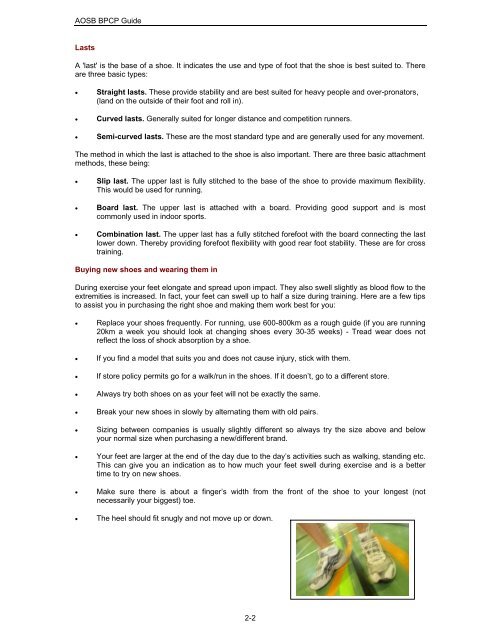Duntroon Army Officer Selection - Australian Army
Duntroon Army Officer Selection - Australian Army
Duntroon Army Officer Selection - Australian Army
Create successful ePaper yourself
Turn your PDF publications into a flip-book with our unique Google optimized e-Paper software.
AOSB BPCP Guide<br />
Lasts<br />
A 'last' is the base of a shoe. It indicates the use and type of foot that the shoe is best suited to. There<br />
are three basic types:<br />
• Straight lasts. These provide stability and are best suited for heavy people and over-pronators,<br />
(land on the outside of their foot and roll in).<br />
• Curved lasts. Generally suited for longer distance and competition runners.<br />
• Semi-curved lasts. These are the most standard type and are generally used for any movement.<br />
The method in which the last is attached to the shoe is also important. There are three basic attachment<br />
methods, these being:<br />
• Slip last. The upper last is fully stitched to the base of the shoe to provide maximum flexibility.<br />
This would be used for running.<br />
• Board last. The upper last is attached with a board. Providing good support and is most<br />
commonly used in indoor sports.<br />
• Combination last. The upper last has a fully stitched forefoot with the board connecting the last<br />
lower down. Thereby providing forefoot flexibility with good rear foot stability. These are for cross<br />
training.<br />
Buying new shoes and wearing them in<br />
During exercise your feet elongate and spread upon impact. They also swell slightly as blood flow to the<br />
extremities is increased. In fact, your feet can swell up to half a size during training. Here are a few tips<br />
to assist you in purchasing the right shoe and making them work best for you:<br />
• Replace your shoes frequently. For running, use 600-800km as a rough guide (if you are running<br />
20km a week you should look at changing shoes every 30-35 weeks) - Tread wear does not<br />
reflect the loss of shock absorption by a shoe.<br />
• If you find a model that suits you and does not cause injury, stick with them.<br />
• If store policy permits go for a walk/run in the shoes. If it doesn’t, go to a different store.<br />
• Always try both shoes on as your feet will not be exactly the same.<br />
• Break your new shoes in slowly by alternating them with old pairs.<br />
• Sizing between companies is usually slightly different so always try the size above and below<br />
your normal size when purchasing a new/different brand.<br />
• Your feet are larger at the end of the day due to the day’s activities such as walking, standing etc.<br />
This can give you an indication as to how much your feet swell during exercise and is a better<br />
time to try on new shoes.<br />
• Make sure there is about a finger’s width from the front of the shoe to your longest (not<br />
necessarily your biggest) toe.<br />
• The heel should fit snugly and not move up or down.<br />
2-2

















